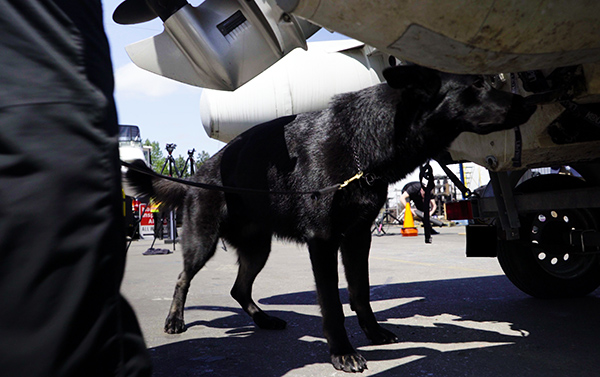Home »

Invasive species programs tackle tiny invaders
Inspection stations are now open throughout the province to prevent harmful zebra and quagga mussels from hitching a ride on boats and entering B.C. waterways.
From now until late October, inspectors with the B.C. Conservation Officer Service (COS) will check boats for aquatic invasive species as part of the Province’s Invasive Mussel Defence Program. Inspectors are educating people about the importance of Clean, Drain and Dry – preventative steps that all boaters should practise when moving between lakes and rivers.
The Invasive Mussel Defence Program has three main components: watercraft inspections, lake monitoring, and public outreach and education. Last year, nearly 30,000 inspections found 16 mussel-fouled boats coming from Ontario, Arkansas, Wisconsin and Manitoba.
Anyone transporting a watercraft (sailboats, motorboats, car toppers, kayaks, canoes and paddle boats) in B.C. is required to stop at an open inspection station. Failing to stop can result in a $345 fine.
From yellow starthistle to Paterson’s curse, zebra and quagga mussels are among a list of invasive species that the province, with support from partners, is working to keep out of B.C. Invasive species can spread rapidly, outcompete or feed on native species, dominate natural and managed areas, and alter ecosystems.
Some invasive species, such as poison hemlock and death cap mushroom, are toxic to people, pets and livestock.
“Invasive species like zebra and quagga mussels are a major threat to our ecosystems and infrastructure in British Columbia,” said George Heyman, Minister of Environment and Climate Change Strategy. “Through our Invasive Mussel Defence Program, we’re taking the necessary steps to protect our waterways today and for the years to come.”
“May is Invasive Species Action Month, which is a great time for each of us to take action to protect our local lands and waters. While staying close to home, we can each make a difference by checking our backyards, planters and local parks to make sure we do not have any unwanted invasive species,” said Dave Bennett, chair, Invasive Species Council of B.C. “Simple actions, such as checking that your tires are clean from seeds and plants before using your bike, trailer or ATV, will help stop the spread. Take the time to be alert, and report any unusual species. You can help protect our habitats from aggressive invasive species.”
The province has invested $12 million to assist with the detection and removal of invasive species.
To prevent the spread of invasive species and encourage public reporting, the province works with the Invasive Species Council of B.C., Indigenous Nations, local and national governments, and community-based organizations.
B.C.’s invasive species programs identify sites where new invasive species have been found and respond quickly to contain and eradicate them before they become established and start spreading.
These initiatives include:
- Working closely with counterparts in Western Canada, the federal government and the U.S. to respond to zebra mussels coming into the country through aquarium plants commonly sold as moss balls in pet stores and garden centres. More than 9,000 moss balls, suspected or confirmed to be contaminated with zebra mussels, have been seized or surrendered to B.C. conservation officers since early March 2021.
- Partnering with Indigenous Nations on a pilot project that monitors for feral pigs in the Chilcotin region. Populations of feral pigs are not known to be established in B.C., but pigs are occasionally reported in the area. The animals can impact native species and degrade ecosystems. In the U.S., they cause an estimated $1.5 billion each year in control costs and damages to agriculture and property.
The Province reminds people to never release pets or plants into rivers, streams, lakes, ponds or storm sewers since they have the potential to start an invasion. People can report sightings of invasive mussels anywhere in B.C. by calling 1-877 -952-7277 and report any invasive species sightings using the Report Invasives BC smartphone app.
Unlike B.C.’s native mussels, zebra and quagga mussels attach to hard surfaces, allowing them to move between waterbodies by boats and equipment. The mussels multiply rapidly and are extremely difficult to eradicate once they become established in an area.
In 2013, the economic impacts of invasive mussels to hydropower, agricultural irrigation, municipal water supplies and recreational boating were estimated to be $43 million per year if introduced into B.C. This does not include additional impacts on commercial and recreational fisheries, tourism or property values.
Lead image: In 2017, the program launched the start of the Aquatic Invasive Species K9 unit and the training of B.C.’s first multipurpose detection dog Kilo. The primary handler of Kilo is Sergeant Josh Lockwood within the Conservation Officer Service (COS). Kilo is trained to detect invasive mussels, firearms and bear parts, and will be used in evidence recovery cases within the Conservation Officer Service. In his first year, Kilo conducted more than 900 inspections and found invasive mussels on two watercraft. In the fall of 2018, Major joined the K9 unit, which makes two for the province. Major is a German shepherd whose primary handler is Sergeant Cynthia Mann. These dogs are valuable tools for detecting invasive mussels on watercraft travelling through and into B.C. B.C. Government photo
e-KNOW







